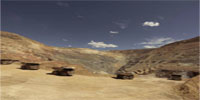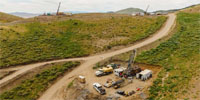
Round Mountain Increased Production Driven By Higher Grades
TORONTO – J. Paul Rollinson, CEO of Kinross Gold Corporation, said, “In Nevada, The decline development at Round Mountain Phase X is advancing well, with over 4,500 metres developed to date. Extensive infill drilling has been completed in both the upper zone and lower zones, with results continuing to intersect strong widths and grades, and extension drilling indicating continuation of mineralization down dip outside the original exploration target. Round Mountain, production was higher quarter-over-quarter driven by higher grades. Production decreased year-over-year as a result of lower mill grades and fewer ounces recovered from the heap leach pads as per planned mine sequencing as the site transitions from Phase W to Phase S. Decline development at Round Mountain Phase X is advancing well, with over 4,500 metres developed to date. Extensive infill drilling has been completed in both the upper zone and lower zones, with results continuing to intersect strong widths and grades, and extension drilling indicating continuation of mineralization down dip outside the original exploration target. Engineering work and technical studies are advancing well to support potential project execution at Phase X.
Kinross plans to provide a project, resource and economics update with year-end results.
Round Mountain is in a transition year in 2025 with mining of Phase W finishing in the third quarter of 2025, while ore mining of Phase S ramps up in the second half of 2025 and into 2026. Exploration activity at Round Mountain includes continued development of the Phase X underground exploration decline and infill drilling in both the upper and lower zones. Tonnes of ore mined decreased by 3% in the second quarter of 2025 compared to same period in 2024, as a result of the ramp down of mining of Phase W and continued Phase S capital development. Mill grades decreased by 35% in the second quarter of 2025 as a result of blending ore from lower mill-grade stockpiles. Tonnes processed increased by 8%, compared to the second quarter of 2024, primarily due to an increase in tonnes of ore placed on the heap leach pads.
Mill recoveries increased by 10% in the second quarter of 2025 compared to the same period in 2024 as a result of mill optimization initiatives.
Tonnes of ore mined decreased by 33% in the first six months of 2025 compared to same period in 2024, as a result of the ramp down of mining of Phase W and continued Phase S capital development. Mill grades decreased by 43% in the first six months of 2025 as a result of blending ore from lower mill-grade stockpiles.
Tonnes processed decreased by 15%, compared to the first six months of 2024, due to a decrease in tonnes of ore placed on the heap leach pads, partially offset by the processing of stockpiled ore.
At our Bald Mountain operation in Nevada, production was higher quarter-over-quarter and year-over-year largely as a result of strong grades and timing of ounces recovered from the heap leach pads, partially offset by fewer tonnes of ore stacked.
Cost of sales per ounce sold was lower quarter-over-quarter and year-over-year as a result of the increase in production and higher proportion of capital development tonnes as mining at Redbird Phase I continues to ramp-up. Redbird, mining is advancing on schedule. Studies and detailed engineering related to the potential Phase 2 extension of Redbird are progressing well, including engineering related to the heap leach pad expansion, technical studies and mine plan optimization work. Exploration drilling and technical studies are also progressing, targeting satellite pit opportunities on the large Bald Mountain property, which could potentially augment the production profile from Redbird 2.”
“Our portfolio of mines continued to perform well during the quarter contributing to a strong first half of the year and positioning us well to achieve our full-year guidance.
The Company delivered a 21% increase in margins of $2,204 compared with Q1 2025, outpacing the 15% increase in the gold price over the same period. We also delivered record free cash flow of approximately $650 million, which increased by 74% compared with the previous quarter. Since reactivating our share buyback program earlier this year, we have repurchased $225 million in shares of the $500 million planned for the year, while maintaining our quarterly dividend and significantly strengthening our investment-grade balance sheet.
We are excited about our pipeline of high-quality development and exploration projects, all of which progressed well during the quarter. We have strong optionality in our substantial resource base and are focused on drilling, technical studies and permitting to advance longer-dated projects into our production profile to extend mine life, with a focus on driving margin growth.
Our 2024 Sustainability Report was released during the quarter, which provides a transparent and comprehensive account of our reporting in this important area. We continue to be focused on sustainability across all aspects of our business, from operations and growth projects, to exploration and strategic priorities. Kinross produced 512,574 Au eq. oz. in Q2 2025, compared with 535,338 Au eq. oz. in Q2 2024.
Higher production from Fort Knox, with the commencement of higher-grade, higher-recovery ore feed from Manh Choh in the second half of 2024, and higher production from Paracatu, was offset by lower production from Tasiast and Round Mountain, as planned.
In the first six months of 2025, Kinross produced 1,059,938 total gold equivalent ounces, comparable to the first six months of 2024. Higher production from Fort Knox, with the commencement of higher-grade, higher-recovery ore feed from Manh Choh in the second half of 2024, and higher production from Paracatu, was offset by lower production from Tasiast, Round Mountain and La Coipa, said Rollinson.“
Fort Knox, in Alaska, production was largely in line quarter-over-quarter, and increased year-over-year as a result of the contribution of Manh Choh’s higher-grade, higher-recovery ore starting in the second half of 2024. The fish populations continue to thrive at Fish Creek based on continuous monitoring by the Alaska department of Fish and Game since the late 1990s. Fish Creek was a historic placer mining area, reclaimed by Kinross in the early 1990s for the benefit of the local communities. Also in Alaska, Kinross continued its longstanding partnership with Trout Unlimited and the Alaska Abandoned Mine Restoration Initiative, with sustained progress in the recovery of fish populations in Resurrection Creek, south of Anchorage, also a placer mining area.
For the Alaska Main Project, Kinross is progressing detailed engineering on the mill, the tailings management facility, and other site infrastructure.
Initial procurement activities for major process equipment have commenced, with awards planned to start in late 2025, and manufacturing for a few long lead items is expected to commence in 2026. In order to advance the Impact Statement (IS) on a timely basis, the Company is coordinating with the Impact Assessment Agency of Canada (IAAC) on a staged filing process. The Company intends to file the majority of the technical chapters by year end and the remaining chapters by the end of the first quarter of 2026. This approach will underpin a robust IS filing with the necessary technical and Indigenous contributions to help facilitate an efficient review process by IAAC.
During the second quarter of 2025, Great Bear incurred $18.3 million on qualifying activities, defined in and required to be disclosed by its Exploration Agreement with Lac Seul First Nation and Wabauskang First Nation, as Exploration Expenditures. Kinross also advanced its regional exploration drilling program during the quarter, targeting favorable geophysical signatures as well as lithological contacts, looking for new, near-surface mineralization. Year-over-year costs decreased as a result of the increase in production, partially offset by higher royalty and reagent costs related largely to the start of Manh Choh production.
Planned mine sequencing at Fort Knox in the second quarter of 2025 included mining of Phase 9 leachable ore and the advancement of Phase 10 as well as higher-grade ore mined from Manh Choh. Tonnes of ore mined decreased by 8% compared to the second quarter of 2024 as Fort Knox is in a period of higher operating waste in accordance with its mine plan, partially offset by an increase in ore mined from Manh Choh.
Mill grades increased by 102% and throughput decreased by 15% compared to the same period in 2024 as the higher-grade Manh Choh ore, which was introduced at the Fort Knox mill in the second half of 2024, requires a longer retention time in the leach circuit. Gold equivalent ounces produced in the second quarter of 2025 increased by 65% compared to the same period in 2024, primarily due to the production of higher-grade, higher-recovery ore from Manh Choh. Gold equivalent ounces sold increased by 61% compared to the second quarter of 2024, due to the increase in production, partially offset by the timing of sales.
At Great Bear, in Ontario, Kinross continues to progress its AEX program, permitting and detailed engineering for the Main Project.
AEX construction commenced in Q4 2024, earthwork activities are underway, and the AEX camp is nearing completion. Initial development of the exploration decline is on target for December 2025, subject to permitting. For the Main Project, Kinross is progressing detailed engineering on the mill, the tailings management facility, and other site infrastructure. Initial procurement activities for major process equipment have commenced, with awards planned to start in late 2025, and manufacturing for a few long lead items is expected to commence in 2026. In order to advance the Impact Statement (IS) on a timely basis, the Company is coordinating with the Impact Assessment Agency of Canada (IAAC) on a staged filing process. The Company intends to file the majority of the technical chapters by year end and the remaining chapters by the end of Q1 2026. This approach will underpin a robust IS filing with the necessary technical and Indigenous contributions to help facilitate an efficient review process by IAAC.
In Mauritania, the Tasiast Mine production decreased quarter-over-quarter and year-over-year driven by planned lower grades and lower throughput. The higher recoveries following a number of optimization initiatives to the mill were partially offset by planned lower grades year-over-year. Cost of sales per ounce sold increased compared with the previous quarter and Q2 2024 due to lower production. Tasiast remains on track to meet its annual guidance. The Tasiast mine is an open-pit operation located in northwestern Mauritania, approximately 300 kilometres north of the capital Nouakchott, which processes ore via mill.
Production at Paracatu Mine, in Brazil, increased quarter-over-quarter due to higher throughput, partially offset by lower grades. Year-over-year production increased due to higher grades and recoveries partially offset by an expected decrease in throughput, as per planned mine sequencing which moved into harder, higher-grade ore this year. Cost of sales per ounce sold was in line with the previous quarter and decreased compared with Q2 2024 due to the increase in production. Paracatu is long life, cornerstone operation located near the city of Paracatu in Brazil’s Minas Gerais region. Paracatu is the largest gold mine in Brazil and one of the largest in the world.
Paracatu is an open-pit mine with ore processed in ball and SAG mills. The mills are expected to continue processing stockpiled ore until 2031. Consistent with Paracatu’s planned mine sequencing, mining in the second quarter of 2025 continued to progress into harder, higher-grade ore, which resulted in lower mill throughput. The Company implemented additional gravity circuit infrastructure in the second half of 2024 contributing to stronger recoveries in the second quarter of 2025. Gold equivalent ounces produced and sold in the second quarter of 2025 increased by 15% and 14%, respectively, compared to the same period in 2024 as a result of the higher grades and recovery, partially offset by the decrease in throughput.
Increases in production quarter-over-quarter at La Copa, in Chile, due to timing of ounces processed through the mill, partially offset by lower grades as a result of decreased ore tonnes mined from the pit and increased feed from low-grade stockpiles driven by higher groundwater inflows into the pits than anticipated.
Relative to Q2 2024, production decreased also due to lower grades with higher feed from low-grade stockpiles. In the second half of the year, production is expected to increase as mining transitions to higher-grade ore from Phase 7, and the mine remains on track to meet its annual production guidance. Cost of sales per ounce sold was higher quarter-over-quarter as a result of the lower grades and higher royalty costs, and year-over-year as a result of the decrease in production and higher royalty, labour and contractor costs. Permitting work for mine life extensions continues, including the submission of the Environmental Impact Assessment during the quarter.
La Coipa contributed to this efficiency through an optimization program of the main processing circuits which resulted in lower water loss going to the dry stack tailings.
Near Maricunga, wetland restoration resulted in the resurgence of ecosystem services and the return of native plant species. Mining at La Coipa in the second quarter of 2025 focused on mining from the Puren pit and capital development of the Phase 7 pit, resulting in a 16% decrease in tonnes of ore mined, a 10% decrease in gold grades, and a 56% decrease in silver grades compared to the same period in 2024. Tonnes of ore mined and grades were also impacted by higher groundwater inflows into the pits than anticipated.
Tonnes processed in the second quarter of 2025 were 3% higher compared to the second quarter of 2024, as a result of blending mined ore with ore from stockpiles, and the realization of the benefits of mill optimization activities in the second half of 2024.
Gold equivalent ounces produced in the second quarter of 2025 decreased by 18% compared to the same period in 2024, primarily due to the decrease in grades. Gold equivalent ounces sold decreased by 21% compared to the second quarter of 2024, due to the decrease in production and the timing of sales. Kinross is progressing baseline studies to support the Environmental Impact Assessment for the Lobo-Marte project. Lobo-Marte continues to be a potential large, low-cost mine and Kinross is committed to progressing next steps to advance the project.
The Curlew Basin exploration drilling, in Washington, continues to intersect high grades and strong widths at both North Stealth and K5, indicating potential to further improve the quality of the resource and the mine plan with additions of high margin mineralization. Extension of the underground declines is progressing well with over 800 metres developed year-to-date, focused on providing drilling access to follow up on the high grade 2023 discovery at Roadrunner and to extend mineralization in the high grade North Stealth area.
Drilling at Curlew continues to intersect high grades and strong widths at both North Stealth and K5, indicating potential to further improve the quality of the resource and the mine plan with additions of high margin mineralization. Extension of the underground declines is progressing well with over 800 metres developed year-to-date, focused on providing drilling access to follow up on the high grade 2023 discovery at Roadrunner and to extend mineralization in the high grade North Stealth area. Technical studies and detailed engineering are also progressing well at Curlew.






